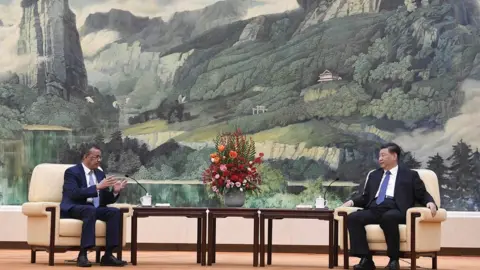Coronavirus: What did China do about early outbreak?
 Getty Images
Getty ImagesThe US and other countries have raised questions about whether China was fully transparent when the virus first emerged there.
So what do we know about what happened in China, and what did it say and do about the outbreak?
Here's our timeline:
1 December - The first onset of symptoms are observed, according to the Lancet medical journal.
However, it's believed the virus first appeared some time in November.
27 December - Chinese authorities are told about a Sars-like disease by a doctor in a provincial hospital in Hubei province.
By this point, cases are multiplying.
30 December - The health commission in Wuhan notifies local hospitals of a "pneumonia of unclear cause", and asks them to report any related information of suspicious cases in the past week.
Ai Fen, a leading doctor at Wuhan Central hospital, receives medical results from a patient with a suspected coronavirus.
Dr Ai takes a photo of the results and sends it to another doctor in the area. It circulates among the medical community in Wuhan.
Another doctor at Wuhan Central hospital, Dr Li Wenliang, sends a message to fellow doctors in a chat group warning them about the outbreak and advising they wear protective clothing to avoid infection. Dr Li is later summoned to the Public Security Bureau and accused of "making false comments" that had "severely disturbed the social order".
Reports spread on Chinese social media platform Weibo of a "mysterious pneumonia", raising fears of a deadly virus.
31 December - Chinese officials confirm they are investigating 27 cases of viral pneumonia and dispatch a team of health experts to the region.
Authorities say seven are in a critical condition yet no human-to-human transmission has been identified.
The authorities alert the World Health Organization (WHO).
1 January - A hospital in Wuhan posts on the Chinese social media platform WeChat that they are "fighting a mysterious pneumonia".
Dr Ai Fen says she is reprimanded by a hospital disciplinary committee for "spreading rumours".
The Wuhan Public Security Bureau detains eight people for spreading rumours about the virus, reporting it on a Chinese news programme, Xinwen Lianbo, a show watched by millions.
The WHO puts itself on an emergency footing to deal with a potential outbreak.
Chinese authorities shut down Huanan Seafood Wholesale Market, the location of a number of cases and a potential source of the virus.
3 January - Various allegations gain traction on Chinese social media, such as local health authorities silencing hospital staff from speaking out about the virus.
(We are unable to independently verify these posts and many were removed by Chinese authorities which heavily censor the internet.)
Wuhan health authorities say it is investigating the cause of the outbreak. Its statement says there has been no human-to-human transmission.
7 January - Chinese top leaders, including President Xi Jinping, discuss the outbreak at a meeting of the standing committee of the politburo, indicating they knew about the virus from an early date.
8 January - A team of experts from the National Health Committee identifies a new coronavirus as the cause of the epidemic.
9 January - China makes public the genome of the coronavirus, proving its link to Sars and Mers viruses. Scientists are now able to develop tests for the virus.
 Getty Images
Getty Images11-17 January - The Chinese Communist Party (CCP) conducts its important annual political meetings for Hubei province. There are no reports of increases in cases during this period.
13 January - The first case outside China is confirmed. The WHO says a traveller from Wuhan was identified by officials in Thailand on 8 January and taken to hospital the same day.
14 January - The WHO posts on Twitter that "preliminary investigations conducted by the Chinese authorities have found no clear evidence of human-to-human transmission."
However, there are reports that local hospitals suspect otherwise due to the number of patients.
15 January - A patient returns to the US from Wuhan and becomes the first known US case of Covid-19.
20 January - A group of health experts at China's National Health Commission confirm human-to-human transmission of the virus, as cases are identified elsewhere in the country.
The first case in South Korea is announced.
20 - 21 January - The WHO sends a delegation to conduct field research in Wuhan. They say evidence suggests human-to-human transmission is taking place but more analysis is needed.

- A SIMPLE GUIDE: What are the symptoms?
- LIKE 9/11 EACH DAY: A New York paramedic's diary
- FACTORY HOTSPOT: The untold story behind America's biggest outbreak
- GUNS & CHEESE: The unexpected items deemed 'essential'
- HOW YOU CAN HELP: Write a diary, donate blood, read books to kids

21 January - China's flagship state-run newspaper, People's Daily, refers to coronavirus for the first time and what President Xi is doing to tackle it.
Up until then, state media is either ignoring or underplaying the outbreak, choosing to concentrate on plans for the Lunar New Year.
Chinese state media confirms 291 cases of coronavirus.
Responding to international pressure about a potential cover-up, Beijing's top political body responsible for law and order says: "Anyone who deliberately delays and hides the reporting of [virus] cases out of his or her own self-interest will be nailed on the pillar of shame for eternity."
The WHO discuss if they should announce that the outbreak is an international health emergency.
23 January - Wuhan (and nearby cities) are put under lockdown.
The WHO decides not to declare an international health emergency.
23-25 January - Construction workers in China start building two new hospitals from scratch.
 Getty Images
Getty Images24-30 January - China celebrates the Lunar New Year holiday, when millions of people travel across the country.
25 January - Chinese officials request all travellers leaving the country to declare their health status.
26 January: The Chinese government imposes a temporary ban on the trade in wild animals throughout the country, which is later made permanent.
28 January - Dr Tedros Ghebreyesus, director general of the WHO, meets President Xi to discuss the outbreak, highlighting it as the institution's top priority.
30 January - The WHO declares Covid-19 a Public Health Emergency of Global Concern - this follows 82 confirmed cases outside China.
Update 10 May: The post about the ban on trade in wild animals was changed to reflect the two-stage process.

